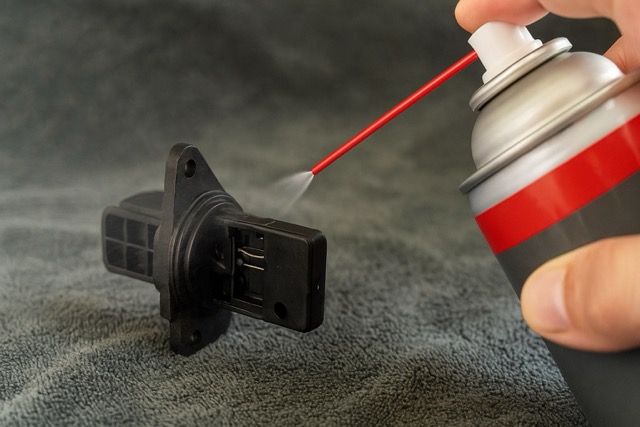Cleaning MAF Sensor With Carb Cleaner (The Hidden Dangers): When your car begins running rough, idling poorly, or burning more fuel than usual, one of the first culprits is often a dirty mass air flow (MAF) sensor. This small device plays a huge role in engine performance because it tells the ECU how much air is entering the engine. If it’s dirty, fuel delivery gets thrown off, and the whole system struggles.
Naturally, many drivers look for quick DIY fixes. One of the most common questions asked online is whether cleaning MAF sensor with carb cleaner is safe. It seems like an easy solution, carburetor cleaner is strong, widely available, and designed to dissolve grease and dirt. But here’s the truth: cleaning MAF sensor with carb cleaner is one of the riskiest mistakes you can make, and it could end up costing you far more than you save.
In this article, we’ll explore why carb cleaner is the wrong choice, what dangers it poses, and which safe alternatives to use instead.

Related:
- Best Ways of Cleaning Mass Air Flow Sensor for Better Fuel Economy
- How to Clean Mass Air Flow Sensor Step by Step (Beginner’s Guide)
- How to Clean MAF Sensor Without Cleaner
Why People Try Cleaning MAF Sensor With Carb Cleaner
Carb cleaner has been around for decades. Before modern electronic fuel injection, carburetors were the standard, and this spray was the go-to product for unclogging jets and removing carbon deposits. Because of its cleaning strength, some DIYers assume carb cleaner will also work for cleaning the mass airflow sensor.
The logic seems sound: if it dissolves stubborn gunk in a carburetor, it should clean a sensor, right? Unfortunately, the chemistry and design of carb cleaners make them far too harsh for the delicate construction of a MAF sensor.
The Risks of Cleaning MAF Sensor With Carb Cleaner
- Harsh Chemicals Damage Delicate Wires
A MAF sensor uses fine platinum or metal film wires to measure airflow. Carb cleaner contains aggressive solvents that can etch, corrode, or completely dissolve protective coatings. Once those wires are damaged, the sensor cannot function correctly, and you’ll be forced to replace it. - Residue Interferes With Readings
Unlike a true mass air flow sensor cleaner spray, carb cleaner doesn’t always evaporate cleanly. It may leave behind residue that alters the way air passes over the sensor, causing inaccurate readings. This leads to poor fuel-air mixtures, engine misfires, or worse, permanent ECU trouble codes. - Short-Term Gain, Long-Term Loss
Some drivers report that cleaning maf sensor with carb cleaner worked temporarily, only to have the sensor fail weeks later. While it may remove dirt, the long-term degradation caused by the chemicals means you’re gambling with a part that costs $150–$400 to replace. - Risk of Over-Spray
Carb cleaner is highly flammable and designed to cut through heavy deposits. If sprayed near plastics, seals, or wiring around the intake system, it can cause cracking or melting. A quick fix could spiral into multiple repair bills.
Safer Alternatives to Carb Cleaner
If you want to avoid these risks, stick with products made specifically for the job:
- Mass air flow sensor cleaner spray → This is residue-free, fast-drying, and safe for delicate wires. Brands like CRC Mass Air Flow Sensor Cleaner are highly recommended by mechanics.
- MAF cleaner → Just another term for the same dedicated product.
- Mass air flow cleaner → Alternative wording, but still the same type of specialized spray.
- Electrical contact cleaner (residue-free) → If you can’t find a proper MAF product, a high-quality contact cleaner can serve as a safe mass air flow sensor cleaner alternative.
Unlike carb cleaner, these sprays are formulated to leave zero residue and evaporate quickly, ensuring the sensor remains accurate after cleaning the mass airflow sensor.
Does Cleaning MAF Sensor With Carb Cleaner Ever Work?
Technically, yes. If you spray carb cleaner on a dirty sensor, it will often remove contaminants. However, the damage it causes to coatings, wires, and surrounding components outweighs the benefit. While you might “get away with it” once, repeated use almost guarantees early failure.
When asked, most mechanics strongly warn against it. They’ve seen customers try cleaning maf sensor with carb cleaner, only to return weeks later needing a new sensor. For a part so sensitive, it’s simply not worth the risk.
The Correct Way to Clean Your MAF Sensor
If your sensor shows symptoms like poor fuel economy, stalling, or a check engine light, follow this safe process instead:
- Turn off the engine and let it cool.
- Locate the sensor between the air filter box and throttle body.
- Remove the sensor carefully, avoiding the wires.
- Spray with mass air flow sensor cleaner using 10–15 bursts.
- Allow it to air dry completely.
- Reinstall and test the car.
This method ensures your clean MAF sensor works like new without risking expensive damage.
Finally, just Don’t use Carb Cleaner
To summarize, while cleaning MAF sensor with carb cleaner might seem like a cheap shortcut, it’s a gamble that can easily backfire. The harsh chemicals, potential residue, and risk of damaging sensitive components make carb cleaner the wrong choice for MAF maintenance.
Instead, always choose a dedicated maf sensor cleaner, such as CRC mass air flow sensor cleaner, or at the very least, a safe mass air flow sensor cleaner alternative like residue-free electrical contact cleaner. Spending a few dollars on the right spray will save you hundreds in replacement costs and keep your engine running smoothly.
So, the next time you think about cleaning the MAF sensor with carb cleaner, remember: it’s one of those hidden dangers that isn’t worth the risk. Stick with the right tools, and your car will thank you with better fuel economy and reliable performance.
Related:
- 2 Ways on How to Clean Oxygen Sensor Without Removing It
- How to Clean Headlights with wd40 & Toothpaste without Removing It
- Tight Alternator Belt Symptoms: How Do I Know If My Alternator Belt Is Tight?
- Why Does My Car Jerk While Driving?
- How to Clean Air Flow Sensor Safely at Home (Tools & Tips)
- How to Clean MAF Sensor With Alcohol: Safe or Risky
